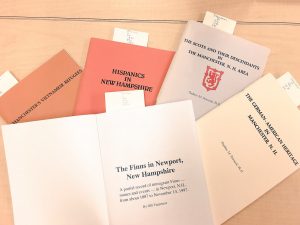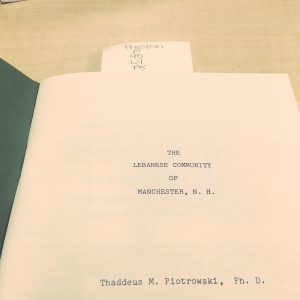Upcoming Goals:
Thursday, Sep. 21: Read half The Finns in Newport, New Hampshire.
Tuesday, Sep. 28: Finish The Finns in Newport, New Hampshire.
Friday, Sep. 29: Visit Newport, NH.
Due Dates:
Thursday, Oct. 5: Final Draft of Contract Due by class time.
Tuesday, Oct. 17: Assignment: Individual Blog Updates. In Class: Check in on Project Progress. Blog/Present in class.
Thursday, Oct. 26: Assignment: Website Perusals in Class and short check-ins on projects.
Tuesday, Oct. 31: Assignment: Rough Draft of Website Due by class time.
Tuesday, Nov. 7: Assignment: Brief check-in/progress report.
Tuesday, Nov. 14: Assignment: Longer check-in/progress report.
Tuesday, Nov. 26: Final Presentation ready.
Thursday, Nov. 28: Blog post reflecting on general experience of researching and building website due.
Monday, Dec. 11: Final Project Websites and Write-ups Due by 3:00 pm Eastern Standard Time.
Finally equipped with a paper copy of Olli Turpeinen’s The Finns in Newport, New Hampshire Patrick and I are ready to experience migration moments that specifically relate to the Finnish migrants to New Hampshire and really move our project forward.[1]
Reading Turpeinen’s history of the Finns in Newport we see a strong connection between the Finnish in Newport and the larger population of Finns in Fitchburg, Massachusetts. We are thinking of creating a website that has two pages, one for Newport, New Hampshire, and one for Fitchburg, Massachusetts. From Turpeinen’s records, it is interesting to identify the different ways in which the Finnish did or did not assimilate themselves into American culture. One way that the Finns preserved their culture upon their arrival to Newport, was to supply themselves with goods from Finnish workers only. When the Finns could not get their goods from Newport they would travel to Fitchburg, MA where they would find all of their needs met through some type of Finnish business. The Finns did this rather than travel to Manchester, New Hampshire, the state’s largest city, because the closest congregation of Finnish immigrants was in Fitchburg, Massachusetts. They kept their traditions by relying mostly on other Finns for advice in regards to medicine or law. Another way the Finns preserved their culture in Newport was by creating a hall, in Newport it was the Finnish Socialist Hall. Not just to promote the socialist political agenda that many Finns in Newport originally supported, the creation of this hall would represent the way that the Finns would attempt to uphold their traditions as it was commonplace for every Finntown to have a social hall.
On the other hand, the Finns in Fitchburg, Massachusetts and Newport, New Hampshire assimilated into American culture by changing their names in almost every case. Turpeinen states that many Finnish changed their names themselves to, “fit better into American scenes”.[2] The Finnish migrant population also assimilated into American culture by assuming the position of the labor force that industrialized America wanted for immigrants, millworkers, and following the mills wherever they went. The Finns arrived in Newport and Fitchburg mainly because of the Mills and they eventually left because work opened up in other mill areas.
Looking further into this book I hope to find more indications of how the culture of Southwestern New Hampshire or Northern Massachusetts influenced the Finns and vice versa. I have a hypothesis that the Finnish psyche played a role in informing the mentality of the average member of a Southwestern New Hampshire or Northern Massachusetts town or city.
[1] Olli Turpeinen, The Finns in Newport, New Hampshire: A Partial Record of Immigrant Finns- Names and Events – in Newport, N.H., from about 1887 to November 14, 1997. (New Brighton, MN: Sampo Publishing, Inc., 2001).
[2] Ibid., 2.

 Patrick Driscoll, my partner in this COPLAC course, and I visited the Keene State College Archives to begin our research on migration history in New Hampshire. It was not the first time we had been here together and our previous experience conducting archival work certainly contributed to the ease of use we had in the facility this time around. We were able to quickly find, not without the help of our lovely archivists, several records of migration populations in New Hampshire. What we discovered were books. Most of these books come from a collection written by Thaddeus M. Piotrowski who spent what seems to be many years compiling information about various immigrant populations existing in New Hampshire, and specifically in the Manchester area, throughout history. Piotrowski produced individual books about each migrant group, went into detail about their histories, cultures, successes and setbacks living in the region, and much more. The groups were: Hispanics in New Hampshire, mostly lured here by an industrialized Granite State’s mills and textiles; Scots and their descendants in Londonderry New Hampshire; German-American groups and their heritage in New Hampshire; Vietnamese refugees of New Hampshire; the Finnish in Newport, New Hampshire, and the Lebanese population in New Hampshire.
Patrick Driscoll, my partner in this COPLAC course, and I visited the Keene State College Archives to begin our research on migration history in New Hampshire. It was not the first time we had been here together and our previous experience conducting archival work certainly contributed to the ease of use we had in the facility this time around. We were able to quickly find, not without the help of our lovely archivists, several records of migration populations in New Hampshire. What we discovered were books. Most of these books come from a collection written by Thaddeus M. Piotrowski who spent what seems to be many years compiling information about various immigrant populations existing in New Hampshire, and specifically in the Manchester area, throughout history. Piotrowski produced individual books about each migrant group, went into detail about their histories, cultures, successes and setbacks living in the region, and much more. The groups were: Hispanics in New Hampshire, mostly lured here by an industrialized Granite State’s mills and textiles; Scots and their descendants in Londonderry New Hampshire; German-American groups and their heritage in New Hampshire; Vietnamese refugees of New Hampshire; the Finnish in Newport, New Hampshire, and the Lebanese population in New Hampshire.